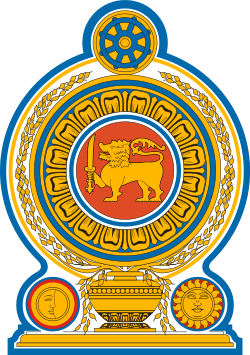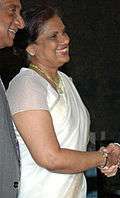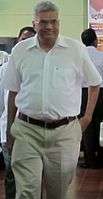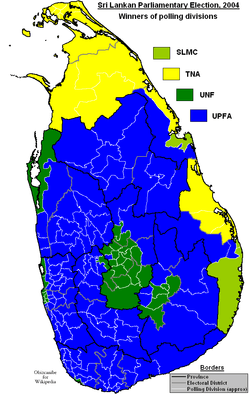Sri Lankan parliamentary election, 2004
| | |||||||||||||||||||||||||||||||||||||||||||||||||||
| |||||||||||||||||||||||||||||||||||||||||||||||||||
| |||||||||||||||||||||||||||||||||||||||||||||||||||
|
| |||||||||||||||||||||||||||||||||||||||||||||||||||
| Winners of polling divisions. UPFA in blue and UNF in green. | |||||||||||||||||||||||||||||||||||||||||||||||||||
| |||||||||||||||||||||||||||||||||||||||||||||||||||
 |
| This article is part of a series on the politics and government of Sri Lanka |
|
|
Political parties |
|
|
|
|
Foreign policy |
|
Related issues
|
Parliamentary elections were held in Sri Lanka on 2 April 2004. The ruling United National Party of Prime Minister Ranil Wickremesinghe was defeated, winning only eighty two seats in the 225-member Sri Lankan parliament. The opposition United People's Freedom Alliance won 105 seats. While this was eight seats short of an absolute majority, the Alliance was able to form a government.
On 6 April President Chandrika Kumaratunga commissioned Mahinda Rajapaksa, a former Labour Minister, as Prime Minister.
Parties
The United People's Freedom Alliance was formed as an alliance between President Kumaratunga's party, the Sri Lanka Freedom Party (SLFP), and the leftist Janatha Vimukthi Peramuna. Other parties that belong to the People's Alliance, such as the Communist Party of Sri Lanka, the Democratic United National Front, the Lanka Sama Samaja Party, Mahajana Eksath Peramuna and the Sri Lanka Mahajana Pakshaya, later joined UPFA.
In the 2001 elections, the People's Alliance and Janatha Vimukthi Peramuna had fought separately. Then the JVP won 9.1% of the vote and sixteen seats. At this election it is reported than as many as thirty nine JVP members won seats as UPFA candidates.
The runner-up in the election was the United National Front (UNF), the front led by the United National Party. In addition to the UNP, the UNF also had candidates from minor parties such as Ceylon Workers Congress.
Other parties winning seats were the Buddhist, Sinhala nationalist outfit Jathika Hela Urumaya (JHU), the pro-LTTE alliance Tamil National Alliance (TNA), the Sri Lanka Muslim Congress (SLMC) and the Eelam People's Democratic Party (EPDP). The Democratic Peoples Liberation Front (the political wing of PLOTE) lost their parliamentary representation.
Campaign
Prime Minister Ranil Wickremasinghe's UNF government had been in limbo since October 2003, when President Kumaratunga declared a state of emergency and took three key cabinet portfolios for her party. During the campaign, she argued that Wickremasinghe had been too soft on the Liberation Tigers of Tamil Eelam and promised to take a harder line. The UNF, for its part, stressed the economic gains that had been made with the ceasefire and the need to find a negotiated solution to the civil war.
Voting
Polling booths opened at 07:00 local time and remained open until 16:00 (01:00 to 10:00 UTC). A total of 10,670 polling stations were installed to receive votes from 12.9 million eligible voters. Voter turnout was high, at around 75%.
The backdrop to polling day was tense, with continued guerrilla activity by Tamil Tiger separatists and five politically motivated murders in the run-up to the election. However, except for a slightly lower turnout in the Eastern Province, Sri Lanka and allegations of fraud in the North, the election was calm and orderly.
Sri Lanka's Elections Commissioner Dayananda Dissanayake said that despite reported cases of electoral malpractice in certain polling stations in six electoral districts, there would be no fresh elections in these areas and the results issued by the Commission were final.
Results
Summary
The United People's Freedom Alliance vote and seat totals are compared with the combined People's Alliance and JVP vote and seat counts at the 2001 election.
| Alliances and parties | Votes | % | Seats | ||||
|---|---|---|---|---|---|---|---|
| District | National | Total | |||||
| United People's Freedom Alliance | 4,223,970 | 45.60% | 92 | 13 | 105 | ||
| United National Front[lower-alpha 2] | 3,504,200 | 37.83% | 71 | 11 | 82 | ||
| Tamil National Alliance[lower-alpha 4] | 633,654 | 6.84% | 20 | 2 | 22 | ||
| Jathika Hela Urumaya | 554,076 | 5.97% | 7 | 2 | 9 | ||
| Sri Lanka Muslim Congress[lower-alpha 3] | 186,876 | 2.02% | 4 | 1 | 5 | ||
| Up-Country People's Front | 49,728 | 0.54% | 1 | 0 | 1 | ||
| Eelam People's Democratic Party | 24,955 | 0.27% | 1 | 0 | 1 | ||
| Independents | 15,865 | 0.17% | 0 | 0 | 0 | ||
| National Development Front | 14,956 | 0.16% | 0 | 0 | 0 | ||
| United Socialist Party | 14,660 | 0.16% | 0 | 0 | 0 | ||
| Ceylon Democratic Unity Alliance | 10,736 | 0.12% | 0 | 0 | 0 | ||
| New Left Front | 8,461 | 0.09% | 0 | 0 | 0 | ||
| Democratic People's Liberation Front | 7,326 | 0.08% | 0 | 0 | 0 | ||
| United Muslim People's Alliance | 3,779 | 0.04% | 0 | 0 | 0 | ||
| United Lalith Front | 3,773 | 0.04% | 0 | 0 | 0 | ||
| National People's Party | 1,540 | 0.02% | 0 | 0 | 0 | ||
| Sinhalaye Mahasammatha Bhoomiputra Pakshaya | 1,401 | 0.02% | 0 | 0 | 0 | ||
| Swarajya | 1,136 | 0.01% | 0 | 0 | 0 | ||
| Sri Lanka Progressive Front | 814 | 0.01% | 0 | 0 | 0 | ||
| Ruhuna People's Party | 590 | 0.01% | 0 | 0 | 0 | ||
| Sri Lanka National Front | 493 | 0.01% | 0 | 0 | 0 | ||
| Liberal Party | 413 | 0.00% | 0 | 0 | 0 | ||
| Sri Lanka Muslim Party | 382 | 0.00% | 0 | 0 | 0 | ||
| Socialist Equality Party | 159 | 0.00% | 0 | 0 | 0 | ||
| Democratic United National Front | 141 | 0.00% | 0 | 0 | 0 | ||
| Valid Votes | 9,262,732 | 100.00% | 196 | 29 | 225 | ||
| Rejected Votes | 534,948 | ||||||
| Total Polled | 9,797,680 | ||||||
| Registered Electors | 12,899,139 | ||||||
| Turnout | 75.96% | ||||||
Province
Electoral District
| District | UNP | UPFA | Other | Valid Votes |
|---|---|---|---|---|
| Anuradhapura | 148,612 (39.9%) 3 seats |
212,943 (57.2%) 5 seats |
JHU: 8,034 (2.2%) | 372,125 |
| Badulla | 181,705 (49.1%) 5 seats |
178,634 (48.3%) 3 seats |
JHU: 6,932 (1.9%) | 370,178 |
| Batticaloa | 6,151 (2.5%) | 26,268 (10.9%) | ITAK: 161,011 (66.7%) 4 seats SLMC: 43,131 (17.9%) 1 seat |
241,375 |
| Colombo | 441,841 (41.8%) 9 seats |
414,688 (39.2%) 8 seats |
JHU: 190,618 (18.0%) 3 seats |
1,057,966 |
| Digamadulla | 42,121 (14.5%) 1 seat |
111,747 (38.5%) 3 seats |
SLMC: 76,563 (26.4%) 2 seats ITAK: 55,533 (19.1%) 1 seat EPDP: 1,611 (0.5%) JHU: 1,130 (0.4%) |
290,361 |
| Galle | 209,399 (38.7%) 4 seats |
306,385 (56.6%) 6 seats |
JHU: 22,826 (4.2%) | 541,511 |
| Gampaha | 367,572 (37.1%) 6 seats |
509,963 (51.5%) 9 seats |
JHU: 102,516 (19.4%) 2 seats |
990,002 |
| Hambantota | 98,877 (35.4%) 2 seats |
178,895 (64.0) 5 seats |
JHU: 1,538 (0.5%) | 279,310 |
| Jaffna | - | - | ITAK: 257,320 (90.6%) 8 seats EPDP: 18,612 (6.5%) 1 seat SLMC: 1,995 (0.7%) |
284,026 |
| Kaluthara | 212,721 (37.8%) 3 seats |
291,208 (51.7%) 6 seats |
JHU: 56,615 (10.1) 1 seat |
563,019 |
| Kandy | 313,859 (50.0%) 6 seats |
268,131 (42.7%) 5 seats |
JHU: 42,192 (6.7%) 1 seat |
627,866 |
| Kegalle | 186,641 (44.3%) 4 seats |
214,267 (50.9%) 5 seats |
JHU: 18,034 (4.3%) | 421,131 |
| Kurunegala | 340,768 (42.9%) 7 seats |
412,157 (51.9%) 9 seats |
JHU: 37,459 (4.7%) | 793,647 |
| Matale | 100,642 (45.7%) 2 seats |
108,259 (49.2%) 3 seats |
JHU: 8,819 (4.0%) | 220,062 |
| Matara | 139,633 (34.9%) 3 seats |
241,235 (60.3%) 5 seats |
JHU: 16,229 (4.0%) | 400,233 |
| Monaragala | 71,067 (37.0) 2 seats |
117,456 (61.1%) 3 seats |
JHU: 2,675 (1.4%) | 192,113 |
| Nuwara-Eliya | 176,971 (54.0%) 4 seats |
82,945 (25.3%) 2 seats |
JHU: 4,454 (1.4%) Other: 63,239 (19.3%) 1 seat |
327,609 |
| Polonnaruwa | 75,664 (40.8%) 2 seats |
106,243 (57.3%) 3 seats |
JHU: 2,413 (1.3%) | 185,261 |
| Puttalam | 135,152 (46.6%) 3 seats |
142,784 (49.3%) 5 seats |
JHU: 10,000 (3.4%) | 289,763 |
| Ratnapura | 205,490 (41.8%) 4 seats |
261,450 (53.1%) 6 seats |
JHU: 20,801 (4.2%) | 492,003 |
| Trincomalee | 15,693 (8.6%) | 31,053 (17.0%) 1 seat |
ITAK: 68,955 (37.7%) 2 seats SLMC: 65,187 (35.7%) 1 seat JHU: 791 (0.4%) EPDP: 540 (0.3%) |
182,794 |
| Vanni | 33,621 (23.9%) 1 seat |
7,259 (05.2%) | ITAK: 90,835 (64.7%) 5 seats EPDP: 1,097 (0.8%) |
140,377 |
Elected members
Notes
- ↑ As People's Alliance
- ↑ The UNF contested under the name and symbol of United National Party.
- 1 2 The SLMC contested separately in four districts (Ampara, Batticaloa, Jaffna and Trincomalee) and with the UNF in all other districts.
- ↑ The TNA contested under the name and symbol of Illankai Tamil Arasu Kachchi.
References
- ↑ "Parliamentary General Election 2004 - All Island Result". Department of Elections, Sri Lanka.
- ↑ "Parliamentary General Election 2004 - Composition of Parliament". Department of Elections, Sri Lanka.
- "Parliamentary General Election 2004 – All Island Result Composition of Parliament". Department of Elections, Sri Lanka.
- "Parliamentary General Election 2004 – All Island Result". Department of Elections, Sri Lanka.
- "Parliamentary General Election 2004 – Final District Results". Department of Elections, Sri Lanka.
- "General Election 2004 Preferences" (PDF). Department of Elections, Sri Lanka.
- "2004 General Election Results". LankaNewspapers.com.
- "Table 43 Parliamentary General Election (Electoral District) (2004)". Sri Lanka Statistics. 10 February 2009.
- "Sri Lanka Parliamentary Chamber: Parliament Elections Held in 2004". Inter-Parliamentary Union.
- "2004 - Parliamentary General Election". Manthree.com.
- "DEMOCRATIC SOCIALIST REPUBLIC OF SRI LANKA LEGISLATIVE ELECTIONS OF 2 APRIL 2004". Psephos - Adam Carr's Election Archive.
- "DEMOCRATIC SOCIALIST REPUBLIC OF SRI LANKA LEGISLATIVE ELECTIONS OF 2 APRIL 2004". Psephos - Adam Carr's Election Archive.


